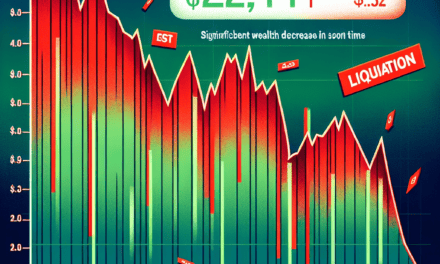“Maximize Your Savings: Secure Up to 5.00% APY with Today’s Money Market Accounts!”
Introduction
As of November 11, 2024, money market accounts are offering competitive interest rates, with some institutions providing annual percentage yields (APYs) as high as 5.00%. These accounts, known for their blend of savings and checking account features, are attracting attention from savers looking to maximize their returns while maintaining liquidity. The current economic climate, characterized by fluctuating interest rates and market conditions, has prompted financial institutions to adjust their offerings, making money market accounts an appealing option for those seeking both security and growth. This trend reflects a broader shift in consumer preferences towards financial products that offer higher yields without sacrificing accessibility.
Understanding Money Market Accounts: A Guide to Earning 5.00% APY
In the ever-evolving landscape of personal finance, money market accounts (MMAs) have emerged as a compelling option for individuals seeking both security and competitive returns on their savings. As of November 11, 2024, these accounts are offering attractive annual percentage yields (APYs) of up to 5.00%, making them a noteworthy consideration for savers. To fully appreciate the benefits of money market accounts, it is essential to understand their unique characteristics and how they compare to other savings vehicles.
Money market accounts are a type of deposit account offered by banks and credit unions, combining features of both savings and checking accounts. They typically offer higher interest rates than traditional savings accounts, which is particularly appealing in today’s economic climate where maximizing returns is a priority for many. The current APY of up to 5.00% is a testament to the competitive nature of these accounts, driven by financial institutions’ desire to attract more deposits.
One of the key advantages of money market accounts is their liquidity. Unlike certificates of deposit (CDs), which require funds to be locked in for a specified term, MMAs allow account holders to access their money with relative ease. This flexibility is facilitated by the ability to write checks and use debit cards, features that are not commonly associated with standard savings accounts. Consequently, money market accounts offer a balance between earning potential and accessibility, making them an attractive option for those who may need to access their funds on short notice.
Moreover, money market accounts are insured by the Federal Deposit Insurance Corporation (FDIC) or the National Credit Union Administration (NCUA), depending on the institution. This insurance provides a safety net for depositors, ensuring that their funds are protected up to the applicable limits. This aspect of security is particularly reassuring in times of economic uncertainty, as it allows individuals to pursue higher yields without compromising the safety of their principal.
However, it is important to note that money market accounts often come with certain requirements and limitations. For instance, they may require a higher minimum balance compared to regular savings accounts. Failing to maintain this balance could result in fees or a reduction in the interest rate offered. Additionally, while MMAs provide more flexibility than CDs, they are still subject to federal regulations that limit the number of certain types of withdrawals and transfers per month. Understanding these conditions is crucial for individuals to make informed decisions about their savings strategy.
In comparison to other savings options, such as high-yield savings accounts or CDs, money market accounts offer a unique blend of benefits. High-yield savings accounts may offer similar interest rates, but they often lack the transactional features of MMAs. On the other hand, CDs might provide higher rates for longer terms, but they lack the liquidity that money market accounts offer. Therefore, the choice between these options largely depends on an individual’s financial goals and needs.
In conclusion, money market accounts present a viable option for savers looking to earn competitive returns while maintaining access to their funds. With rates reaching up to 5.00% APY, they offer an attractive combination of yield, security, and flexibility. As with any financial decision, it is essential for individuals to carefully evaluate their personal circumstances and consider the specific terms and conditions of the account before committing. By doing so, they can effectively leverage the benefits of money market accounts to enhance their financial well-being.
Comparing Money Market Account Rates: How to Maximize Your Earnings
In the ever-evolving landscape of personal finance, money market accounts (MMAs) have emerged as a popular choice for individuals seeking a balance between liquidity and higher interest rates. As of November 11, 2024, these accounts offer competitive annual percentage yields (APYs), with some institutions providing rates as high as 5.00%. Understanding how to navigate and compare these rates is crucial for maximizing your earnings and making informed financial decisions.
To begin with, it is essential to comprehend what a money market account entails. MMAs are a type of savings account that typically offer higher interest rates than traditional savings accounts. They achieve this by investing in short-term, low-risk securities. While they share similarities with savings accounts, such as federal insurance protection, they often come with features akin to checking accounts, including check-writing privileges and debit card access. This combination of benefits makes them an attractive option for those who wish to earn more on their deposits while maintaining easy access to their funds.
When comparing money market account rates, several factors should be considered to ensure you are making the most of your investment. First and foremost, the APY is a critical component. This figure represents the real rate of return on your deposit, taking into account the effect of compounding interest. A higher APY means more earnings on your balance over time. However, it is important to note that the highest APY may not always be the best choice if it comes with restrictive terms or conditions.
In addition to the APY, account fees and minimum balance requirements are significant considerations. Some MMAs may offer enticing rates but impose monthly maintenance fees or require a substantial minimum balance to avoid such fees. These costs can erode your earnings, so it is vital to weigh them against the potential interest income. Furthermore, some accounts may have tiered interest rates, where higher balances earn higher rates. Understanding these tiers can help you determine the most advantageous account for your financial situation.
Another aspect to consider is the institution offering the money market account. Established banks, credit unions, and online financial institutions all provide MMAs, each with its own set of advantages. Traditional banks may offer the convenience of physical branches, while online banks often provide higher rates due to lower overhead costs. Credit unions, on the other hand, may offer competitive rates and personalized customer service. Evaluating the reputation and customer service of the institution can provide peace of mind and ensure a positive banking experience.
Moreover, it is prudent to stay informed about the broader economic environment, as interest rates can fluctuate based on monetary policy and market conditions. Keeping an eye on the Federal Reserve’s actions and economic indicators can provide insights into potential rate changes, allowing you to make timely adjustments to your financial strategy.
In conclusion, money market accounts present a viable option for those seeking to enhance their savings with higher interest rates while maintaining liquidity. By carefully comparing APYs, fees, minimum balance requirements, and the reputation of financial institutions, you can maximize your earnings and make sound financial decisions. As the financial landscape continues to evolve, staying informed and adaptable will be key to optimizing your money market account strategy.
The Benefits of High-Yield Money Market Accounts in 2024
In the ever-evolving landscape of personal finance, high-yield money market accounts have emerged as a compelling option for individuals seeking to maximize their savings. As of November 11, 2024, these accounts offer attractive annual percentage yields (APY) of up to 5.00%, making them a noteworthy consideration for those looking to grow their wealth with minimal risk. Understanding the benefits of high-yield money market accounts in 2024 requires a closer examination of their features, advantages, and the current economic context.
To begin with, high-yield money market accounts combine the best features of savings and checking accounts, offering both competitive interest rates and liquidity. Unlike traditional savings accounts, which often provide lower interest rates, money market accounts are designed to offer higher returns, making them an appealing choice for savers. The current rate of up to 5.00% APY is particularly significant, as it reflects the broader economic conditions, including the Federal Reserve’s interest rate policies aimed at curbing inflation while promoting economic stability.
Moreover, the flexibility of money market accounts is another key advantage. Account holders can typically access their funds with ease, often through checks or debit cards, which is not always possible with other high-yield savings options like certificates of deposit (CDs). This liquidity ensures that individuals can manage their finances effectively, balancing the need for growth with the ability to respond to unexpected expenses or opportunities.
In addition to their attractive interest rates and liquidity, money market accounts are also considered a safe investment. They are insured by the Federal Deposit Insurance Corporation (FDIC) up to the legal limit, providing peace of mind to account holders. This insurance guarantees that even in the unlikely event of a bank failure, the depositor’s funds are protected, making money market accounts a low-risk option for conservative investors.
Furthermore, the competitive rates offered by money market accounts in 2024 are a reflection of the broader economic environment. As inflationary pressures persist, financial institutions are incentivized to offer higher yields to attract depositors. This dynamic creates a favorable situation for savers, who can benefit from the increased competition among banks and credit unions. Consequently, individuals are encouraged to shop around and compare different institutions to find the best rates and terms that suit their financial goals.
Additionally, the rise of digital banking has made it easier than ever to open and manage money market accounts. Many online banks offer higher APYs compared to their brick-and-mortar counterparts, as they have lower overhead costs. This trend has democratized access to high-yield accounts, allowing more people to take advantage of the benefits they offer.
In conclusion, high-yield money market accounts in 2024 present a valuable opportunity for individuals seeking to enhance their savings with minimal risk. With rates reaching up to 5.00% APY, these accounts offer a compelling combination of safety, liquidity, and competitive returns. As the financial landscape continues to evolve, staying informed about the benefits and features of money market accounts can empower savers to make sound financial decisions. By leveraging the advantages of these accounts, individuals can effectively navigate the complexities of today’s economic environment and work towards achieving their financial objectives.
How to Choose the Best Money Market Account for Your Financial Goals
In the ever-evolving landscape of personal finance, selecting the right money market account (MMA) is crucial for achieving your financial goals. As of November 11, 2024, money market account rates have become increasingly competitive, with some institutions offering up to 5.00% annual percentage yield (APY). This presents a unique opportunity for savers to maximize their returns while maintaining liquidity. However, choosing the best account requires careful consideration of several factors beyond just the interest rate.
To begin with, understanding the nature of money market accounts is essential. MMAs are a type of savings account that typically offer higher interest rates than traditional savings accounts. They achieve this by investing in short-term, low-risk securities. While they provide the benefit of higher returns, they also come with certain limitations, such as minimum balance requirements and restrictions on the number of transactions per month. Therefore, when selecting an MMA, it is important to assess your financial habits and needs.
One of the primary considerations should be the interest rate offered. While a 5.00% APY is attractive, it is vital to read the fine print. Some accounts may offer a high introductory rate that decreases after a certain period. Others might require a substantial minimum balance to qualify for the advertised rate. Thus, it is advisable to compare the terms and conditions of various accounts to ensure that the rate is sustainable and aligns with your financial situation.
In addition to the interest rate, consider the fees associated with the account. Some money market accounts charge monthly maintenance fees, which can erode your earnings. Look for accounts that offer fee waivers if you maintain a certain balance or meet other criteria. Furthermore, be aware of any penalties for exceeding transaction limits, as these can also impact your overall returns.
Another important factor is the accessibility of funds. Money market accounts typically allow for a limited number of withdrawals or transfers each month. If you anticipate needing frequent access to your funds, ensure that the account you choose offers sufficient flexibility. Additionally, consider whether the institution provides convenient access through online banking, mobile apps, or a network of ATMs.
Security is another critical aspect to consider. Ensure that the money market account is offered by a reputable financial institution and that it is insured by the Federal Deposit Insurance Corporation (FDIC) or the National Credit Union Administration (NCUA). This insurance protects your deposits up to the legal limit in the event of a bank failure, providing peace of mind.
Moreover, consider the reputation and customer service of the financial institution. Reading reviews and seeking recommendations can provide insights into the experiences of other customers. A bank or credit union with a strong reputation for customer service can make managing your account more pleasant and efficient.
In conclusion, while the prospect of earning up to 5.00% APY on a money market account is enticing, it is crucial to evaluate all aspects of the account to ensure it aligns with your financial goals. By considering factors such as interest rates, fees, accessibility, security, and customer service, you can make an informed decision that maximizes your savings potential while providing the flexibility and security you need. As you navigate the options available, remember that the best money market account is one that not only offers competitive returns but also supports your broader financial strategy.
Money Market Accounts vs. Savings Accounts: Which Offers Better Returns?
In the ever-evolving landscape of personal finance, individuals are constantly seeking ways to maximize their returns on savings. As of November 11, 2024, money market accounts (MMAs) have emerged as a compelling option, offering rates as high as 5.00% annual percentage yield (APY). This development prompts a closer examination of how money market accounts compare to traditional savings accounts in terms of potential returns and overall benefits.
To begin with, it is essential to understand the fundamental differences between money market accounts and savings accounts. Both are designed to help individuals save money while earning interest, yet they differ in terms of structure and functionality. Savings accounts are typically straightforward, offering a fixed interest rate with limited access to funds. In contrast, money market accounts often provide higher interest rates and come with features such as check-writing capabilities and debit card access, making them more versatile for account holders.
The current financial climate has seen a notable increase in the interest rates offered by money market accounts. This rise can be attributed to various economic factors, including changes in the Federal Reserve’s monetary policy and fluctuations in the broader financial markets. As a result, MMAs have become increasingly attractive to savers looking to earn more on their deposits. With rates reaching up to 5.00% APY, these accounts present a significant opportunity for individuals to grow their savings more rapidly than they might in a traditional savings account.
However, while the allure of higher returns is undeniable, it is crucial to consider the potential trade-offs. Money market accounts often require a higher minimum balance to open and maintain the account compared to savings accounts. This requirement can be a barrier for some individuals, particularly those who are just beginning to build their savings. Additionally, while MMAs offer more flexibility in terms of access to funds, they may also come with limitations on the number of transactions allowed per month, similar to savings accounts.
Despite these considerations, the potential for higher returns makes money market accounts an appealing option for those who can meet the minimum balance requirements. Moreover, the increased interest rates can significantly enhance the growth of savings over time, especially for larger deposits. This advantage is particularly relevant in today’s economic environment, where inflationary pressures can erode the purchasing power of money held in low-yield accounts.
In contrast, traditional savings accounts, while offering lower interest rates, provide a level of simplicity and accessibility that may be preferable for some savers. These accounts typically have lower minimum balance requirements and fewer restrictions on transactions, making them suitable for individuals who prioritize ease of use and liquidity over maximizing returns.
Ultimately, the decision between a money market account and a savings account should be guided by an individual’s financial goals, risk tolerance, and liquidity needs. For those who can afford to maintain higher balances and seek to capitalize on the current high-interest rates, money market accounts offer a compelling opportunity to enhance their savings. Conversely, individuals who value simplicity and accessibility may find traditional savings accounts to be a more suitable choice.
In conclusion, as money market account rates soar to impressive heights, they present a viable alternative to traditional savings accounts for those seeking better returns. By carefully weighing the benefits and limitations of each option, savers can make informed decisions that align with their financial objectives and ultimately achieve greater financial security.
The Impact of Interest Rate Changes on Money Market Accounts
In the ever-evolving landscape of personal finance, money market accounts (MMAs) have emerged as a popular choice for individuals seeking a balance between liquidity and higher interest rates. As of November 11, 2024, these accounts are offering attractive annual percentage yields (APYs) of up to 5.00%, a significant increase compared to previous years. This rise in interest rates can be attributed to several factors, primarily the broader economic environment and monetary policy adjustments. Understanding the impact of these changes on money market accounts is crucial for investors aiming to maximize their returns while maintaining a degree of financial flexibility.
To begin with, it is essential to recognize that money market accounts are interest-bearing deposit accounts that typically offer higher interest rates than traditional savings accounts. They achieve this by investing in short-term, low-risk securities such as Treasury bills and commercial paper. The interest rates on MMAs are closely tied to the federal funds rate, which is the interest rate at which banks lend to each other overnight. When the Federal Reserve adjusts this rate, it directly influences the interest rates offered by financial institutions on various deposit accounts, including money market accounts.
In recent years, the Federal Reserve has implemented a series of interest rate hikes in response to inflationary pressures and a robust economic recovery. These rate increases have led to a corresponding rise in the yields offered by money market accounts. Consequently, account holders are now able to earn up to 5.00% APY, a rate that was unimaginable just a few years ago. This development has made MMAs an attractive option for savers who wish to earn a competitive return without exposing themselves to the volatility of the stock market.
Moreover, the increase in money market account rates has implications for both individual savers and the broader financial system. For savers, higher interest rates mean that their deposits can grow more rapidly, enhancing their ability to achieve financial goals such as building an emergency fund or saving for a major purchase. Additionally, the liquidity offered by MMAs allows account holders to access their funds with relative ease, providing a level of financial security that is particularly valuable in uncertain economic times.
On a larger scale, the rise in money market account rates reflects the Federal Reserve’s efforts to manage economic growth and control inflation. By increasing the federal funds rate, the central bank aims to moderate borrowing and spending, thereby cooling down an overheated economy. This, in turn, helps to stabilize prices and maintain purchasing power for consumers. As a result, the higher yields on MMAs can be seen as part of a broader strategy to ensure sustainable economic growth.
In conclusion, the current landscape of money market account rates, with yields reaching up to 5.00% APY, is a direct consequence of recent changes in monetary policy and economic conditions. For individual savers, these higher rates offer an opportunity to enhance their financial well-being while maintaining access to their funds. At the same time, the broader implications of these rate changes underscore the interconnectedness of personal finance and macroeconomic policy. As interest rates continue to evolve, staying informed about these dynamics will be essential for anyone looking to make the most of their money market accounts.
Tips for Opening a Money Market Account with Competitive Rates
In the ever-evolving landscape of personal finance, money market accounts have emerged as a popular choice for individuals seeking a balance between liquidity and higher interest rates. As of November 11, 2024, some financial institutions are offering money market account rates as high as 5.00% APY, making it an opportune time to consider opening one. However, to maximize the benefits of these competitive rates, it is essential to approach the process with a strategic mindset. By understanding the nuances of money market accounts and employing a few key strategies, you can ensure that you select an account that aligns with your financial goals.
To begin with, it is crucial to conduct thorough research on the various financial institutions offering money market accounts. Not all banks and credit unions provide the same rates or terms, so comparing options is vital. Online banks often offer higher rates than traditional brick-and-mortar institutions due to lower overhead costs. Therefore, exploring online options can be advantageous. Additionally, consider the reputation and stability of the institution, as these factors can impact the security of your funds.
Once you have identified potential institutions, the next step is to scrutinize the account terms and conditions. While a high APY is attractive, it is important to be aware of any associated fees that could erode your earnings. Common fees include monthly maintenance fees, which can sometimes be waived if you maintain a minimum balance. Furthermore, be mindful of transaction limits, as exceeding the allowed number of withdrawals or transfers per month could result in additional charges. Understanding these terms will help you avoid unexpected costs and make an informed decision.
In addition to fees, consider the minimum balance requirements of the money market accounts you are evaluating. Some accounts with higher APYs may require a substantial initial deposit or a high minimum balance to maintain the advertised rate. Assess your financial situation to determine if you can comfortably meet these requirements without compromising your liquidity needs. If maintaining a high balance is not feasible, it may be more beneficial to opt for an account with a slightly lower rate but more manageable terms.
Moreover, it is wise to evaluate the accessibility and convenience of the account. With the rise of digital banking, many institutions offer robust online and mobile banking platforms, allowing you to manage your account with ease. Features such as mobile check deposit, online bill pay, and ATM access can enhance your banking experience. Ensure that the institution you choose provides the level of convenience you require to manage your finances efficiently.
Finally, consider the broader economic context when opening a money market account. Interest rates are influenced by various factors, including Federal Reserve policies and economic conditions. Staying informed about these trends can help you anticipate potential changes in rates and make timely decisions. While locking in a high rate is appealing, remain flexible and open to adjusting your strategy as the financial landscape evolves.
In conclusion, opening a money market account with competitive rates requires careful consideration and strategic planning. By conducting thorough research, understanding account terms, evaluating balance requirements, and considering accessibility, you can select an account that not only offers a high APY but also aligns with your financial needs. As you navigate the process, remain informed about economic trends to ensure that your money market account continues to serve your best interests in the long term.
Q&A
1. **What is the highest APY available for money market accounts as of November 11, 2024?**
– The highest APY available is 5.00%.
2. **Which financial institutions are offering competitive money market account rates?**
– Various online banks, credit unions, and traditional banks are offering competitive rates, but specific names are not provided.
3. **What factors should be considered when choosing a money market account?**
– Consider the APY, minimum balance requirements, fees, withdrawal limits, and the financial institution’s reputation.
4. **Are there any fees associated with money market accounts?**
– Some accounts may have monthly maintenance fees, but these can often be waived by meeting certain balance requirements.
5. **How do money market accounts differ from savings accounts?**
– Money market accounts typically offer higher interest rates and may provide check-writing and debit card access, but they often require higher minimum balances.
6. **What is the typical minimum balance requirement for a high-yield money market account?**
– Minimum balance requirements can vary, but they often range from $1,000 to $10,000.
7. **Are money market accounts FDIC insured?**
– Yes, money market accounts offered by banks are generally FDIC insured up to $250,000 per depositor, per institution.
Conclusion
As of November 11, 2024, money market account rates have become increasingly competitive, with some institutions offering up to 5.00% APY. This reflects a broader trend of rising interest rates, likely influenced by economic conditions and monetary policy adjustments. For savers, this presents an attractive opportunity to earn higher returns on their deposits compared to traditional savings accounts. However, it’s important for consumers to carefully evaluate the terms and conditions associated with these accounts, including any fees or minimum balance requirements, to ensure they are maximizing their potential earnings while maintaining liquidity and flexibility.





